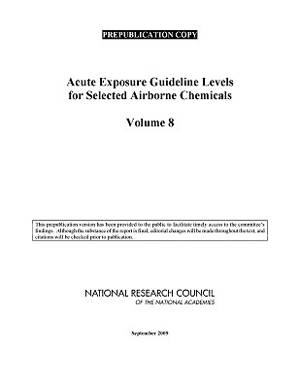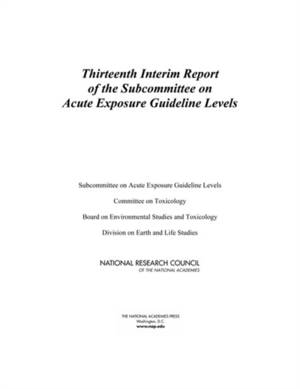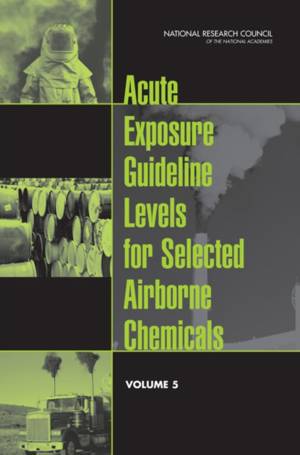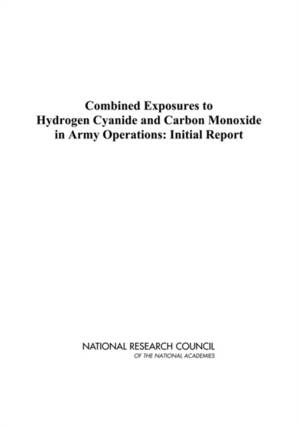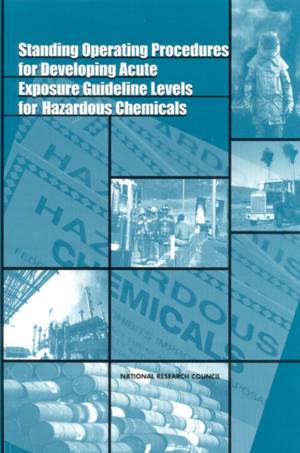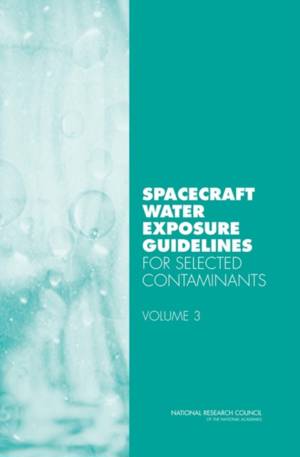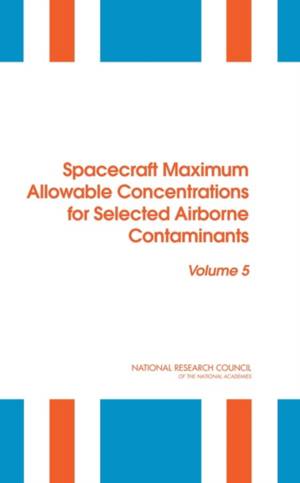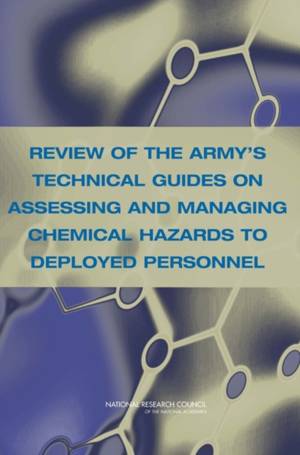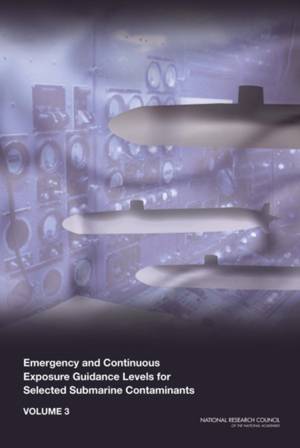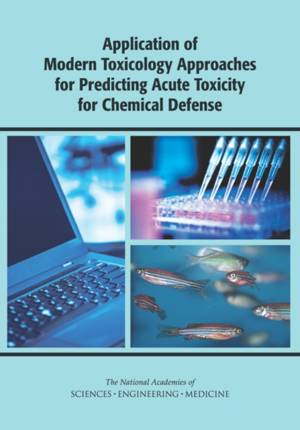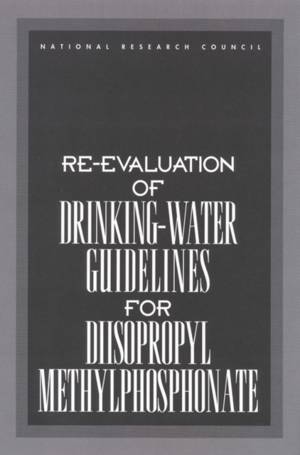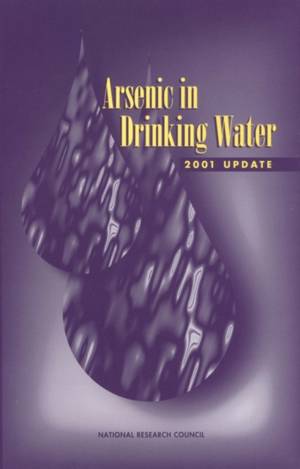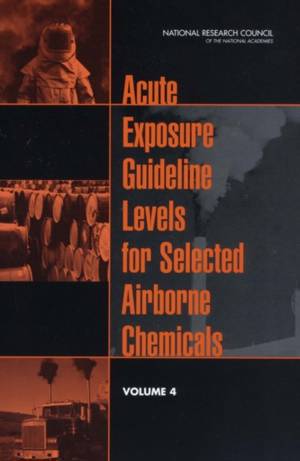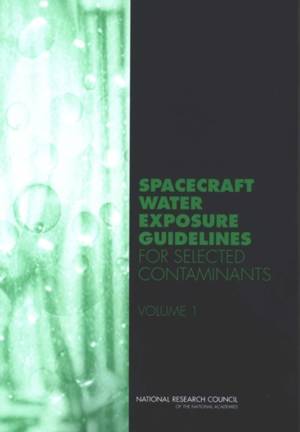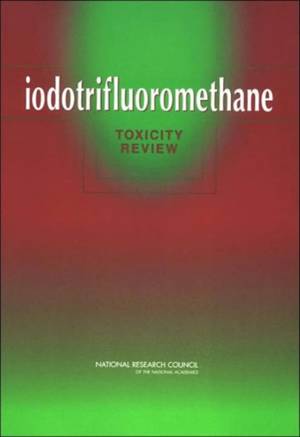
- Afhalen na 1 uur in een winkel met voorraad
- Gratis thuislevering in België vanaf € 30
- Ruim aanbod met 7 miljoen producten
- Afhalen na 1 uur in een winkel met voorraad
- Gratis thuislevering in België vanaf € 30
- Ruim aanbod met 7 miljoen producten
Zoeken
Resultaten voor "Committee on Toxicology"
-
Acute Exposure Guideline Levels for Selected Airborne Chemicals, Volume 18
National Research Council, Division on Earth and Life Studies, Board on Environmental Studies and Toxicology, Committee on Toxicology, Committee on Acute Exposure Guideline Levels
- Paperback | Engels
- Extremely hazardous substances can be released accidentally as a result of chemical spills, industrial explosions, fires, or accidents involving railr... Lees meer
€ 78,45Levering 1 à 2 weken€ 78,45Levering 1 à 2 weken -
Acute Exposure Guideline Levels for Selected Airborne Chemicals
National Research Council, Board on Environmental Studies and Toxicology, Committee on Toxicology, Committee on Acute Exposure Guideline Levels
- Paperback | Engels
- This book is the eighth volume in the series Acute Exposure Guideline Levels for Selected Airborne Chemicals, and reviews AEGLs for acrolein, carbon m... Lees meer
€ 133,45Verwachte beschikbaarheidsdatum onbekend€ 133,45Verwachte beschikbaarheidsdatum onbekend -
Thirteenth Interim Report of the Subcommittee on Acute Exposure Guideline Levels
National Research Council, Division on Earth and Life Studies, Board on Environmental Studies and Toxicology, Committee on Toxicology, Subcommittee on Acute Exposure Guideline Levels
- Paperback | Engels
- Formed in 1995 by EPA, several other federal and state agencies, and several private organizations, the National Advisory Committee on Acute Exposure ... Lees meer
€ 31,45Verwachte beschikbaarheidsdatum onbekend€ 31,45Verwachte beschikbaarheidsdatum onbekend -
Acute Exposure Guideline Levels for Selected Airborne Chemicals
National Research Council, Division on Earth and Life Studies, Board on Environmental Studies and Toxicology, Committee on Toxicology, Committee on Acute Exposure Guideline Levels
- Paperback | Engels
- In 1993, the National Research Council's Committee on Toxicology developed criteria and methods for EPA and the Agency for Toxic Substances and Diseas... Lees meer
€ 121,45Verwachte leverdatum onbekend€ 121,45Verwachte leverdatum onbekend -
Combined Exposures to Hydrogen Cyanide and Carbon Monoxide in Army Operations
National Research Council, Division on Earth and Life Studies, Board on Environmental Studies and Toxicology, Committee on Toxicology, Committee on Combined Exposures to Hydrogen Cyanide and Carbon M
- Paperback | Engels
- In response to a request from the U.S. Army, a committee convened by the National Research Council (NRC) conducted the first in a sequence of studies ... Lees meer
€ 37,45Verwachte beschikbaarheidsdatum onbekend€ 37,45Verwachte beschikbaarheidsdatum onbekend -
Standing Operating Procedures for Developing Acute Exposure Guideline Levels for Hazardous Chemicals
National Research Council, Commission on Life Sciences, Board on Environmental Studies and Toxicology, Committee on Toxicology, Subcommittee on Acute Exposure Guideline Levels
- Paperback | Engels
- Standing Operating Procedures for Developing Acute Exposure Guideline Levels for Hazardous Chemicals contains a detailed and comprehensive methodology... Lees meer
€ 81,45Verwachte leverdatum onbekend€ 81,45Verwachte leverdatum onbekend -
Spacecraft Water Exposure Guidelines for Selected Contaminants
National Research Council, Division on Earth and Life Studies, Board on Environmental Studies and Toxicology, Committee on Toxicology, Committee on Spacecraft Exposure Guidelines
- Paperback | Engels
- NASA maintains an active interest in the environmental conditions associated with living and working in spacecraft and identifying hazards that might ... Lees meer
€ 91,95Verwachte beschikbaarheidsdatum onbekend€ 91,95Verwachte beschikbaarheidsdatum onbekend -
Spacecraft Maximum Allowable Concentrations for Selected Airborne Contaminants
National Research Council, Division on Earth and Life Studies, Board on Environmental Studies and Toxicology, Committee on Toxicology, Committee on Spacecraft Exposure Guidelines
- Paperback | Engels
- NASA is aware of the potential toxicologic hazards to crew that might be associated with prolonged spacecraft missions. Despite major engineering adva... Lees meer
€ 152,95Verwachte beschikbaarheidsdatum onbekend€ 152,95Verwachte beschikbaarheidsdatum onbekend -
Review of the Army's Technical Guides on Assessing and Managing Chemical Hazards to Deployed Personnel
National Research Council, Division on Earth and Life Studies, Board on Environmental Studies and Toxicology, Committee on Toxicology, Subcommittee on the Toxicological Risks to Deployed Military Per
- Paperback | Engels
- To guide mission planning, military decision makers need information on the health risks of potential exposures to individual soldiers and their poten... Lees meer
€ 94,95Verwachte leverdatum onbekend€ 94,95Verwachte leverdatum onbekend -
Emergency and Continuous Exposure Guidance Levels for Selected Submarine Contaminants
National Research Council, Division on Earth and Life Studies, Board on Environmental Studies and Toxicology, Committee on Toxicology, Committee on Emergency and Continuous Exposure Guidance Levels f
- Paperback | Engels
- U.S. Navy personnel who work on submarines are in an enclosed and isolated environment for days or weeks at a time when at sea. Unlike a typical work ... Lees meer
€ 87,45Verwachte beschikbaarheidsdatum onbekend€ 87,45Verwachte beschikbaarheidsdatum onbekend -
Application of Modern Toxicology Approaches for Predicting Acute Toxicity for Chemical Defense
National Academies of Sciences Engineering and Medicine, Division on Earth and Life Studies, Board on Life Sciences, Board on Environmental Studies and Toxicology, Committee on Toxicology, Committee on Predictive-Toxicology Approaches for Military Asses
- Paperback | Engels
- The US Department of Defense (DOD) is faced with an overwhelming task in evaluating chemicals that could potentially pose a threat to its deployed per... Lees meer
€ 85,95Verwachte leverdatum onbekend€ 85,95Verwachte leverdatum onbekend -
Re-Evaluation of Drinking-Water Guidelines for Diisopropyl Methylphosphonate
National Research Council, Commission on Life Sciences, Board on Environmental Studies and Toxicology, Committee on Toxicology, Subcommittee on the Toxicity of Diisopropyl Methylphosphonate
- Paperback | Engels | Compass
- Diisopropyl Methylphosphonate (DIMP) is a groundwater contaminant at the U.S. Army's Rocky Mountain Arsenal in Colorado. DIMP is a by-product created ... Lees meer
€ 31,45Verwachte leverdatum onbekend€ 31,45Verwachte leverdatum onbekend -
Arsenic in Drinking Water
National Research Council, Division on Earth and Life Studies, Board on Environmental Studies and Toxicology, Committee on Toxicology, Subcommittee to Update the 1999 Arsenic in Drinking Water Report
- Paperback | Engels
- Having safe drinking water is important to all Americans. The Environmental Protection Agency's decision in the summer of 2001 to delay implementing a... Lees meer
€ 78,95Verwachte leverdatum onbekend€ 78,95Verwachte leverdatum onbekend -
Acute Exposure Guideline Levels for Selected Airborne Chemicals
National Research Council, Division on Earth and Life Studies, Board on Environmental Studies and Toxicology, Committee on Toxicology, Subcommittee on Acute Exposure Guideline Levels
- Paperback | Engels
- The Bhopal Disaster of 1984 resulted in the death of around 2,000 residents living near chemical plants and irreversible injuries to more than 20,000 ... Lees meer
€ 111,45Verwachte leverdatum onbekend€ 111,45Verwachte leverdatum onbekend -
Spacecraft Water Exposure Guidelines for Selected Contaminants
National Research Council, Division on Earth and Life Studies, Board on Environmental Studies and Toxicology, Committee on Toxicology, Subcommittee on Spacecraft Exposure Guidelines
- Paperback | Engels
- To protect space crews from contaminants in potable and hygiene water, NASA requested that the National Research Council (NRC) provide guidance on how... Lees meer
€ 125,95Verwachte leverdatum onbekend€ 125,95Verwachte leverdatum onbekend -
Combined Exposures to Hydrogen Cyanide and Carbon Monoxide in Army Operations
National Research Council, Division on Earth and Life Studies, Board on Environmental Studies and Toxicology, Committee on Toxicology, Committee on Combined Exposures to Hydrogen Cyanide and Carbon M
- Paperback | Engels
- To determine whether the air quality inside armored-vehicle cabins can meet exposure guidelines under deployment conditions, the Army assessed possibl... Lees meer
€ 31,45Verwachte beschikbaarheidsdatum onbekend€ 31,45Verwachte beschikbaarheidsdatum onbekend -
Iodotrifluoromethane
National Research Council, Division on Earth and Life Studies, Board on Environmental Studies and Toxicology, Committee on Toxicology, Subcommittee on Iodotrifluoromethane
- Paperback | Engels
- The U.S. military is considering using a compound called iodotrifluoromethane (CF3I) for fire suppression to replace previously-used compounds (halons... Lees meer
€ 60,95Verwachte beschikbaarheidsdatum onbekend€ 60,95Verwachte beschikbaarheidsdatum onbekend
17 van 17 resultaten getoond







